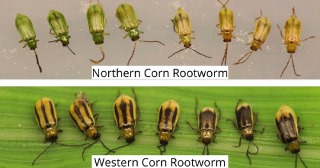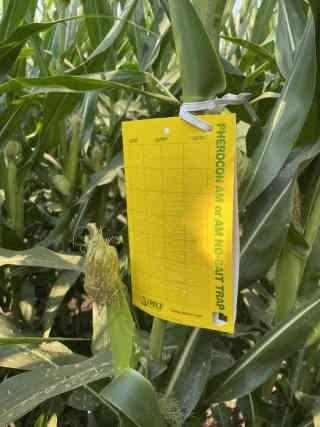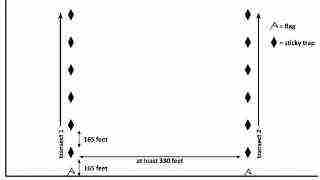By Ashley Dean, Dr. Erin Hodgson
Western and northern corn rootworms are serious pests of corn throughout the Corn Belt (Photo 1). We recommend that farmers scout every cornfield every year, regardless of the management tactic(s) used, to evaluate management decisions and prepare for next year. It is a good idea to scout for larvae early in the season, assess root injury when larval feeding wraps up, and monitor adults later in the season. Since beetle emergence is underway throughout most of the state, now is a good time to begin planning for monitoring adults with sticky traps.

Photo 1. Top: northern corn rootworm adults range from tan to green in color. Bottom: western corn rootworm adults are yellow with black stripes that sometimes look like a smudge. Photos by Adam Varenhorst.
Monitoring adults
Usually, adult emergence coincides with silking (R1), because the adults like to feed on pollen so females can fertilize eggs. However, delayed planting throughout much of Iowa means that many fields are behind schedule and silking is occurring now. If adults emerge into fields without silks, they will feed on leaves or nearby flowering plants (i.e., weeds, soybeans) until the silks come out. Keep in mind:
- Adult emergence lasts 6-8 weeks;
- Westerns emerge before northerns; and
- Males emerge before females.
To monitor adults, follow the guidelines outlined below. Use Pherocon AM yellow sticky traps (unbaited). Set up sticky traps (Photo 2) at corn silking and continue through the dent stage (i.e., mid-July through August). For areas in eastern counties with suspected rotation-resistant western corn rootworm, set up sticky traps at soybean flowering and continue through full seed set (i.e., mid-July through August).

Photo 2. Sticky traps for corn rootworm adult monitoring should be attached directly to the stalk at ear height. Photo by Ashley Dean.
What you need: To monitor adults, you will need Pherocon AM unbaited sticky traps, twist ties, and flags.
Steps:
- For every 10-50 acres of corn or soybean, create two transects of six sticky traps (Figure 1). Transects should be at least 330 feet apart. Use a flag or stake to mark transects along the field edge.
- Place the first trap at least 165 feet in from the field edge; place remaining traps within the same row and at least 165 feet apart.
- For corn, attach the sticky trap directly to the developing ear (Photo 2). For soybean, attach the sticky trap to a post approximately 18 inches above the canopy.
- Check traps weekly and count the number of western and northern corn rootworms. Replace sticky traps weekly.
- For each sample, estimate the average number of western and northern corn rootworms per trap per day. For example, 123 total corn rootworms/12 traps/7 days = 1.46 rootworms/trap/day.

Figure 1. Schematic drawing of adult corn rootworm sticky traps in corn or soybean fields.
In addition to this full protocol, a modified version is available that is used in the Regional Corn Rootworm Adult Monitoring Network. If using the modified protocol, scouting should begin approximately two weeks after adults begin emerging in the area to capture peak emergence. Find more information on trapping protocols, trap brand options, and where to purchase sticky traps on the Corn Rootworm IPM website. You can see live maps of corn rootworm trap captures throughout the season from cooperators in the regional network on the mapping website.
Why scout?
What does it mean? The action threshold in corn is two corn rootworms/trap/day, regardless of species. Consider crop rotation if action thresholds are met. If planting corn again the following growing season, use a pyramided Bt trait with Cry34/35Ab1, or a soil-applied insecticide on non-rootworm Bt corn. Action thresholds in soybean are 1.5 western corn rootworms/trap/day. If action thresholds are met in soybean, consider using a pyramided Bt trait or a soil-applied insecticide on non-rootworm Bt corn the following season or using an extended rotation (something other than corn).
Farmers have several management tactics available for suppressing corn rootworm larvae, including soil-applied insecticides, Bt corn hybrids (including those with RNAi), and crop rotation. Although both species are persistent pests, western corn rootworm is particularly adaptable. The Gassmann Lab at Iowa State University (ISU) has confirmed western corn rootworm resistance to all four Bt rootworm traits in Iowa. Although not present in Iowa yet, North Dakota has confirmed northern corn rootworm resistance to Cry3Bb1 and Cry34/35Ab1, and Nebraska has confirmed western corn rootworm resistance to insecticides. Scouting for corn rootworm allows farmers to make management decisions for next year and will prolong the efficacy of the few management tactics we have for this persistent pest.
Source : iastate.edu